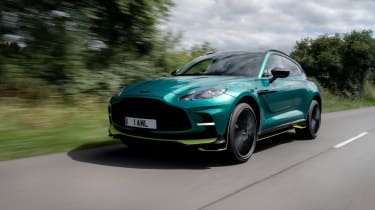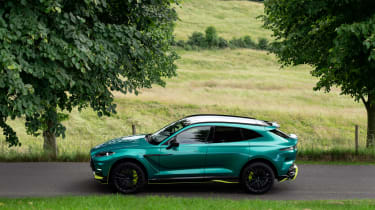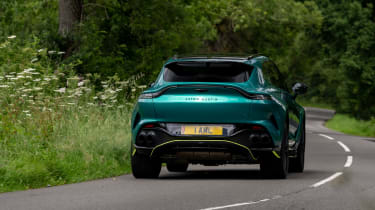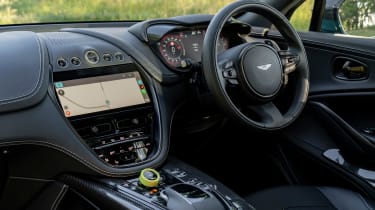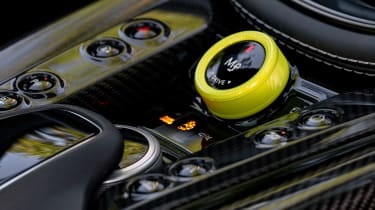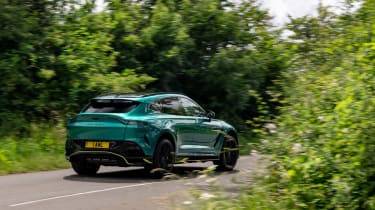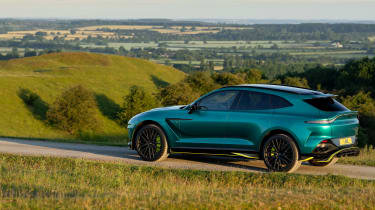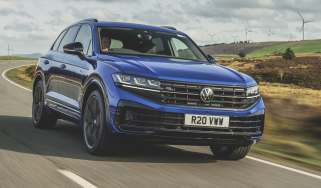Aston Martin DBX707 2023 review – has Porsche’s Cayenne Turbo GT met its match?
The 697bhp DBX707 is big, brash and financially friendly for Aston Martin, but also comes with some deftness to its chassis
Regardless of your feelings towards vehicles like the Aston Martin DBX707, the rollout of ever faster, more powerful and more extreme super-SUVs isn’t coming to an end anytime soon. The majority understand why manufacturers are hooked on them: they deliver huge profit margins, which is justification enough for their makers to seemingly contradict their claims to be on the road to carbon net zero and continue to sell you a car that’s heavy, big and powered by an engine that struggles to reach 20mpg. So while there are enough people with strong enough credit lines to fuel them, 600bhp-plus behemoths are here to stay and to help fund the scramble to electrification.
Just as many of Aston’s rivals need their SUVs, so the British marque needs the DBX, and needs to offer more than one flavour of it, which it already does following the launch of the mild-hybrid six-cylinder variant in China at the tail end of 2021. Europe and the rest of the world will have to wait until the 2024 facelift before it can plug its DBX in to charge a battery pack, but in the meantime the 707 has arrived.
As the most powerful production SUV in the world, it’s a headline-generating DBX that AM hopes will push sales closer to the 4000 units a year it is budgeting on (Lamborghini sold over 5000 Uruses in 2021). It’s also been roped into the Formula 1 circus as the official medical car from the 2023 season, building on the strengths of the previous DBX medical car with the added performance and track-focus to try keep up with the AMG safety car ahead of it.
More reviews
At the same time the 707 is tasked with adding some much-needed profit to the bottom line, drawing customers away from the aforementioned Lamborghini and the top-end Porsche Cayenne Coupé models, and gaining enough traction to distract as many as possible from Range Rover’s new BMW-engined turbocharged V8 Sport SVR that arrives in 6 months’ time.
There is much to be impressed by with the regular V8 DBX, specifically that it conducts itself on the road in a manner more in keeping with a supersaloon than an SUV. This is due to a dynamic set-up that doesn’t bludgeon the road and a performance delivery that’s more sniper than blunderbuss. It’s also a car that any sane individual wouldn’t step away from wishing it had nearly 30 per cent more power, or the ability to crack 197mph or reach 60mph in 3.1 seconds. After running one on evo’s Fast Fleet for 12,000 miles neither did we think it needed to be stiffer, more aerodynamically efficient or have a larger tyre footprint. Unlike Aston Martin, who clearly did and therefore has given it all of the above. But rather than eradicating all that is good about the regular DBX in the process, it’s turned the car we shouldn’t rate so highly, but do, into one that we have an even higher opinion of.
Initial fears that the DBX’s smooth running would be turned brittle by stiffening the top mounts by 55 per cent and increasing body stiffness by nine per cent take little time to be expunged, as the car’s inherent compliance and calmness are immediately evident. So too is the increased flattening of the body now that 50 per cent more torque is put through the electronic anti-roll-bar system to reduce body roll at low speeds and when you’re simply moving along rather than pressing on.
Yet the ride is now more supple, forgiving and strangely more relaxing at low speed than its less powerful brother. The regular DBX is already pretty remarkable at how it manages its mass and centre of gravity, avoiding the trap that all but a few SUVs fall into of feeling like they’re of an old-school body-on-ladder-frame construction despite their thoroughly 21st-century platforms. It’s what gives the Aston its super-estate-car feel, and in the 707 it’s ratcheted up to a higher level still. Even on its new (optional) 23-inch wheels and tyres it takes a particularly nasty crevice in the tarmac to send a shudder through the body or cabin.
Changes to the three-chamber air suspension system and the damper rates across all driver modes from GT through to Sport + (the Terrain modes are left alone) play their part, too, but a great deal of the higher levels of body control and ride quality can be attributed to the fitment of hydrobushes to the front suspension. These were installed on the early launch cars of the original DBX but didn’t make production due to durability concerns. Now they’ve passed the test, so Aston has fitted them to the 707 and plans to roll them out across the other DBX models, too. Their role is to dampen the forces taken from the front axle to keep the steering as calm as possible and also to manage the unsprung weight that’s inevitable when you fit 23-inch wheels and tyres along with the brakes – standard carbon-ceramics measuring 420mm front and 390mm rear – required to slow a 2245kg SUV with 697bhp. It’s one of the most immediate transformations of the car, shutting down the low-speed patter to provide a genuine GT-esque ride quality.
Which is clever and essential stuff, because it’s likely that if you’re in the market to buy a £189,000, near-700bhp Aston Martin that seats five and covers tarmac without flinching, you’ll want a ride as cosseting as a Bentley’s, which it certainly has when compared with the Bentayga. There will also be some who sign on the line for a 707 because it’s the most powerful and fastest DBX you can buy. The performance comes courtesy of AMG’s M177 4-litre twin-turbocharged V8, the engine found in all eight-cylinder Aston Martins and quite a few Mercedes-AMG products too, only the specification here results in the most powerful V8-engined Aston you can buy.
New ball-bearing turbochargers are fitted, there’s revised fuel and valve mapping and an exhaust system that’s new front to back, and the engine’s brain has had the mother of all reboots to get to that 697bhp, all yours at 6000rpm, with 664lb ft of torque delivered from 2600rpm through to 4500rpm – increases of 155bhp and 148lb ft over the V8 in the standard DBX. While the automatic gearbox still has nine ratios, they are part of a new wet-clutch transmission that has also been through the Aston Martin gym to sharpen shift responses and maximise the potential of its shorter final drive ratio, while a recalibration to the software results in more torque going to the rear axle more of the time.
The quiet-start function will be appreciated by neighbours in close proximity to 707 owners, but even in its loudest setting the tone has less of the bark and blare of old. At a push you might even call it cultured. But your mind is soon distracted from the soundtrack to the light interior makeover that has taken place, key amongst the changes being the fitment of a rotary dial to control the driving modes, replacing the buttons on the centre console of the original car. There’s still no touchscreen for the HMI (that’s coming in 2024) but the new sports seats pinch you tighter across the shoulders and the wider range of interior colours go further to lift the cabin ambience.
There isn’t a savage shove from this revised V8 that means it out-muscles the recently announced V12 Vantage – the SUV gives 76bhp in the power-to-weight battle to the sleek coupe – but there is more of an edge to throttle inputs, and while peak torque arrives 400rpm later and drops off 500rpm earlier than with the regular V8 DBX, there’s more of it arriving lower down, which makes the 707 a sharper, more responsive machine.
Turn the mode dial to Sport or Sport+ and the V8 awakens like a poked bear, the revs taking huge swipes around the tacho, speed building at a rate that makes you grateful for the polish that’s been applied to the chassis and the linear response of a steering rack that appears to have forgotten it’s in control of an SUV and not one of Aston’s front-engined GTs.
There’s plenty of grip, as you’d expect from 275-wide front and 310-wide rear Pirelli P Zeros, but it doesn’t mask what’s going on, which makes positioning Aston’s answer to Porsche’s hottest Cayenne a more precise process. Settle into a rhythm and relax rather than trying to hustle the 707 and it flows with a more connected feel and sense of engagement than a non-Competition BMW M5 or an Audi RS6, feeling more organic and natural in how it drives rather than like it’s relying on technology to get it down the road.
The technology it does have at its disposal is complementary rather than interfering. The four-wheel-drive modes have been optimised to better suit the engine’s increased power and torque outputs, with the 707 rear-wheel drive until it feels the need to send torque to the front axle, which means it drives out of corners with an unexpected poise rather than scrambling out on all fours and pawing at the surface. In quicker turns it feels balanced from the moment you turn in to the second you squeeze open the throttle, being as far removed from a point-and-squirt super-SUV as you can imagine. It’s a car that you admire more for its core competencies and capabilities than your self-consciousness tells you that you should.
Ultimately the DBX707 is a highly polished evolution of the impressive original DBX. Gains have been made where they were needed rather than for the sake of it to grab a viral audience, although Aston Martin is quite keen to build on the ‘most powerful SUV’ tag, and with Tobias Moers at the helm you know a DBX707 will be rolling into the paddock of the Nürburgring as soon as the weather permits in an attempt to claim the Cayenne Turbo GT’s SUV lap record crown. No, I’m not sure why, but if that’s what the boss wants, that’s what he gets, I guess.
To aid it around the lap the aero upgrades will come into play far more than they did on our Sardinian test route. Granted, a number of the aero tweaks to the body are to aid cooling, such as the front splitter that helps reduce drag while keeping lift neutral, and alongside the front winglets also cools the monstrous carbon brakes so they maintain their well-modulated feel and retardation performance – pretty impressive for a car so big when driven up and over a quick mountain pass. The 40kg reduction in unsprung mass across all four corners is welcome, too. Those front winglets are also designed to reduce turbulence around the front wheels, while additions to the side sills and a vent in each rear quarter panel are designed to draw air through and away from the rears. Combined with a larger than expected rear diffuser, which also features its own secondary wing, and a carbon extension to the roof spoiler, the DBX certainly makes a statement over its regular siblings. The rear diffuser looks like it should have a ‘no step’ sign affixed to it.
With each passing mile the 707 impresses. As a purist you continue to look for flaws, of which there are some: it’s still a big car, no matter how tightly it wraps itself around you, and while it rides with exceptional quality at all speeds and feels precise and faithful through every twist and turn, your grey matter is always yelling at you that something that weighs two and quarter tons, is five metres long, nearly two metres wide and 1.7 metres high isn’t going to come out on top with physics if it starts to get a little out of hand. And when you’re pushing on, the active anti-roll bars sometimes exaggerate the car’s cornering flatness in and through a corner to the point of distraction, as if the tyres aren’t quite keyed into the surface.
It remains impressive that you feel in control of the 707, that it doesn’t set out to scare you or impress you just for the sake of it. There’s real depth to its development that’s very easy to experience and hard not to appreciate. It’s more rounded than Porsche’s Cayenne Turbo GT, although not as laser focused on outright performance, feeling content to sacrifice some thrills for a less tense approach to everything it does. And it knocks a Lamborghini Urus for six (can something be knocked for seven? If so, that’s the Lambo), making the Italian feel flatfooted and one dimensional.
What is key to remember with a car such as the DBX707 is that it’s not designed to replace another model in the Aston Martin line-up; in the company’s eyes it’s an addition to a front-engined GT car from Gaydon. More importantly, it’s been designed, developed (to an unbelievably high standard, it has to be said) and sold to help fund the next generations of today’s iconic GT cars and tomorrow’s ambitious mid-engined models, which will all have plugs. That it has been done so to the same exacting standards as the firm’s more traditional products does not go unnoticed.
While there are customers willing to pay for them, manufacturers will continue to build more powerful, faster and less appropriate super-SUVs. Yet while the majority will continue to fall short on delivering on their performance promise, the DBX707 certainly doesn’t.
Prices and rivals
With prices kicking off at £189,000 before options, most DBX707s are very likely to pop over the £200,000 mark with an option or two selected, although the standard specification is pretty extensive. Its closest rival in terms of performance and capability is the £147,510 Porsche Cayenne Turbo GT, a 631bhp flagship that’s proven to be the more agile and energetic car, but lacks some of the Aston’s languid GT-like qualities, not to mention a special-ness that permeates from its interior.
More compromised rivals include the £164,000 Lamborghini Urus S and Performante, which despite sharing a large proportion of its hardware is nowhere near the Porsche in terms of capability or engagement. The new £187,800 Bentley Bentayga V8 S is certainly less of a sporting SUV when compared to the Aston or either of its aforementioned VW Group cousins, but the its 2020 update saw a big step up in terms of comfort and quality, and the changes to its chassis have resulted in the best driving Bentayga to date.
Specs
| Engine | V8, 3982cc, twin-turbo |
| Power | 697bhp @ 6000rpm |
| Torque | 663lb ft @ 2600-4500rpm |
| Weight | 2245kg |
| Power-to-weight | 315bhp/ton |
| 0-62mph | 3.3sec |
| Top speed | 193mph |
| Basic price | £189,000 |

